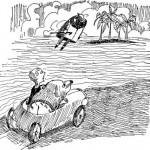I looked at three of the works in the Electronic Literature Collection Volume One, however I was entranced by Inanimate Alice, going so far as to pursue the other episodes. As I worked through each of the short interactive episodes, I couldn’t help but feel that this sort of thing was where the future lies. Semi-interactive and pure convergence.
The simplicity of the stories themselves were a strong point. We are rapidly coming to the point where we all have handhelds like Alice’s and we will be getting all of our media through them. In cases like that, a book cannot just be words. All the media elements, music, video, pictures, interactivity, have to come together and feed into the work, not just feed off it (in the case of transmedia). All the elements have to feed together in a seamless whole. In Alice’s case, they did and they did so because all the elements were simple ones. It was an even playing field.
The simplicity of the controls was important as well, opening up the work to people with all levels of computer knowledge. You could conceivably see this played with a remote on a TV screen.
A narrative is a delicate thing, and Alice has got it just right. Gardner called narrative “a fictional dream” and as such it is delicate, it can take the smallest mistype to disturb it and break the reader/viewer out of their dream. This is even harder with a convergent-based story because any of the multimedia elements could jar the viewer out of the narrative dream. The creators of Inanimate Alice understood that. It feels like some sort of future journal by this young girl who is just as confused as we are. The viewer sees the story unfold bit-by-bit along with Alice. The whole experience, blurred photos, odd and sometimes skipping music, and the story of a girl who seems so… lost… is haunting. As a work of fiction it is flawless.
The truth of the matter is that interactive (and convergent) storytelling does not lie purely with games. Normal games remain too insulated within their own culture and difficult for the regular consumer and casual games, in order to remain casual, rely on mechanics too simplistic for story-telling. In the future of convergence and storytelling, what will fulfill the casual readers’ niche? What sort of medium could (to use a rather crude test) you read on the toilet? Inanimate Alice is this future. In this medium we see where those of us who read books will soon be heading.
—————-
I also looked at Deviant: The Possession of Christian Shaw which was just too weird and insular for me. I felt like there was a completely unattainable story and that anyone without previous knowledge of the real life event would be completely lost. Instead of telling me a story, it was just disturbing.
—————
The first work I looked at was The Fall of the Site of Marsha. It was very clearly inspired by horror movies, even directly sharing some of the imagery (the flickering angel). It is not a whole narrative, not really, but it is disturbing and the story is clear enough. Besides being a horror story it seemed interested in little else. The concept was interesting enough, but concept alone cannot make up for a failure of narrative. If this were a movie, it would be a B horror flick.
You can see my full notes on Marsha here.
All in all, quite interesting, I’ll have to take a look at some of the other works later.





























Great commentary, Aram.
I thought the Marsha site was commenting on the popular conception of angels versus the accounts one finds in ancient texts (angels are not cute and cuddly fat kids with wings).
I don’t know, the Marsha site seemed very unoriginal to me. I mean, the concept was something new, but the narrative that was being created was right out of a B horror real. I don’t think it was a commentary on angels as much as it was an attempt to bring that sort of very hackneyed horror concept to a different medium.